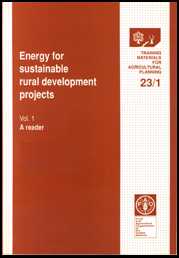
TRAINING MATERIALS FOR AGRICULTURAL PLANNING 23/1
Food and Agriculture Organization of the United Nations Rome, 1991
|
The designations employed and the presentation of material in this publication do not imply the expression of any opinion whatsoever on the part of the Food and Agriculture Organization of the United Nations concerning the legal status of any country, territory, city or area or of its authorities, or concerning the delimitation of its frontiers or boundaries. |
All rights reserved. No part of this publication may be reproduced, stored in a retrieval system, or transmitted in any form or by any means, electronic, mechanical, photocopying or otherwise, without the prior permission of the copyright owner. Applications for such permission, with a statement of the purpose and extent of the reproduction, should be addressed to the Director, Publications Division, Food and Agriculture Organization of the United Nations, Viale delle Terme di Caracalla, 00100 Rome, Italy.
© FAO 1991
This electronic document has been scanned using optical character recognition (OCR) software and careful manual recorrection. Even if the quality of digitalisation is high, the FAO declines all responsibility for any discrepancies that may exist between the present document and its original printed version.
Chapter 1 - Basic energy concepts
1. Introduction
2. Forms of energy
3. Energy conversion
4. Energy and power
5. Energy sources
6. Some notes on energy terminology
7. Energy flow
8. Energy units and dimensions
9. Energy losses and efficiency
10. Equivalence and replacement of energy forms
11. Energy balance
12. Process energy requirements and gross energy requirements
13. Examples of calculations of energy conversions
Chapter 2 - Energy concerns and the project cycle
1. Project identification
2. Identification of energy constraints
3. Identification of opportunities
4. Preliminary screening of project alternatives1. Project preparation
2. Beneficiary participation in project design
3. Detailed analysis of energy constraints and requirements
4. Design of energy componentsIII. Project appraisal
IV. Project monitoring and evaluation
V. Conclusions
Chapter 3 - Economics of energy in agriculture and rural development projects
Key economic efficiency issues
Non-economic efficiency criteria
Case studies applying foregoing concepts
Towards some synthesis
Chapter 4 - Comparison of energy alternatives for small-scale irrigation
Introduction
1 Technical calculations1.1 Farm size and crops
1.2 Water requirements
1.3 Energy requirements
1.4 specific fuel consumption
1.5 Plant sizing to meet peak loads2.1 Project costing assumptions and estimates
2.2 Base case technology choice alternatives
2.3 Base case cost and revenue comparisons
2.4 Economic pricing
2.5 Sensitivity analyses
Chapter 5 - Agro-forestry, a new fashion of old tradition?
Introduction
I. A new interest
II. Agro-forestry; adding trees to farming systems?
III. Agro-forestry techniques
IV. Financial and economic implicationsA. Benefits and costs to the farmer
B. The government's perspectiveV. Preparation and implementation issues
A. Rural appraisals
B. Project components
C. National and local institutions
Appendix 1
Appendix 2 (a)
Appendix 2 (b)